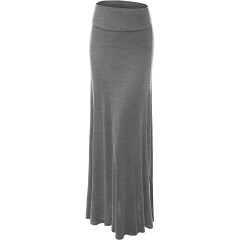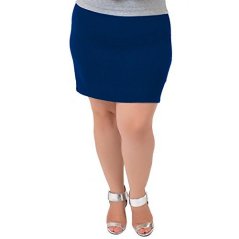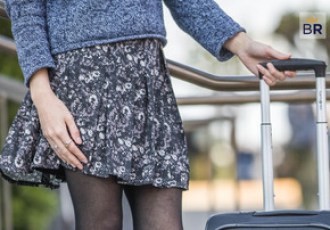
A simple A-line design available in 10 colors; it's the go-to skirt for countless women.
A simple A-line design available in 10 colors; it's the go-to skirt for countless women.
Skirt is unbelievably comfortable and runs true to size. Pockets are small, but they're actually functional. Made with quality stretch denim that holds its shape well without feeling rough or stiff. Popular for workplaces.
Some report that the skirt doesn't hold up well to frequent wash and wear.

Wearers love how easy it is to dress up with this soft maxi skirt.
Wearers love how easy it is to dress up with this soft maxi skirt.
Made with a slinky polyester and Spandex blend. Won't wrinkle. Wide waistband offers moderate control and smoothing. Colors are vibrant and won't bleed in the wash. Hem is double stitched and won't fray or unravel.
Lighter colors of this skirt can be somewhat sheer and revealing.

By far the best option if you're looking for a great skirt for a night out.
By far the best option if you're looking for a great skirt for a night out.
Skirt is well-cut and doesn't ride up toward the back. Has a sleek, near seamless appearance with understated stitching. Totally breathable with a cotton material blend. Waistband is universally flattering and comfortable.
Skirt runs shorter than expected, especially on taller wearers.

It's easy to fall in love with the patterns of these skirts, not to mention their flattering cut.
It's easy to fall in love with the patterns of these skirts, not to mention their flattering cut.
Available in far more sizes than most skirts. Design is structured, yet its polyester blend offers a decent flexibility. Wearers love the high waistband and the silhouette it creates. Hemline is ideal, even with a difference in height among wearers.
Sizing is fairly hit or miss, and many wearers had to try more than one size.

This stretch denim skirt is a crowd favorite due to its relaxed design and soft material blend.
This stretch denim skirt is a crowd favorite due to its relaxed design and soft material blend.
Classic design that has a tough style with contrast stitching and waistband ruching. Skirt is the perfect length and breathable, so it can be worn year round and works well for layering. Has a small slit in the back to prevent it from riding up.
Given its very relaxed cut, it's not very structured or figure-flattering.

We recommend these products based on an intensive research process that's designed to cut through the noise and find the top products in this space. Guided by experts, we spend hours looking into the factors that matter, to bring you these selections.

Every woman’s wardrobe should be well-stocked with fashion staples, including skirts. According to many women, skirts are more versatile and comfortable than pants. And dramatically different styles, such as a fitted pencil skirt and a casual maxi skirt, pair well with classic blouses or tank tops. In order to have the right skirt on hand for any occasion, it’s a good idea to invest in multiple styles, materials, and colors. In fact, most women’s closets hold an average of three to five skirts.
Of course, no matter how fashionable the skirt, finding the right fit is essential. For one, skirts should be comfortable enough to sit in and move freely. For the best fit, however, it’s often recommended that you take your skirt to a skilled tailor. With a little fine-tuning, a skirt can be transformed into a flattering, custom article of clothing.
If you’re curious about which styles you should invest in, we invite you to read our buying guide on women’s plus-size skirts. We cover everything you need to know and include a few helpful shopping and styling tips.

In a world of jeans and yoga pants, many women wonder if there’s still a place for skirts outside of formal occasions and business settings. The simple answer is yes — skirts are here to stay.
For one, there are countless styles, so a coordinated look will always be modern and fashionable. Pairing a skirt with the right accessories also elevates it into the category of contemporary fashion. A classic metro-chic style, for example, features a full A-line skirt, crisp collared blouse, and wide belt.
Certain skirt styles have become more popular in the last decade, especially maxi skirts made of jersey cotton blends. It’s a skirt that can be styled in countless ways. Pair it with a sleeveless tank and a denim jacket for casual wear, or wear it with a tailored blazer for a business casual look. Maxi skirts are solid options for beach cover-ups, too.
One of the most common questions women ask about skirts is what type of footwear looks best with them. There are several factors to consider, such as season, weather conditions, length, and how formal the skirt is.
From a practical standpoint, it’s always recommended that you choose footwear that protects your feet appropriately. Cute strappy sandals are a solid option for denim mini skirts in warm weather; however, when the temperature drops, it’s best to swap the sandals for boots.
Many women choose footwear based on a skirt’s length to achieve a more flattering silhouette from head to toe. Many narrow or fitted skirts, for example, are most effective at elongating and flattering your figure when worn with high-heeled shoes or sandals.
The right footwear can dress up or dress down a skirt. Consider a classic design: a black form-fitting pencil skirt. When worn with conservative pumps or wedges, the skirt takes on a professional appearance. If you swap those shoes for stilettos or fancy high-heeled sandals, the skirt can double as a classy date night garment.
While a skirt with pockets is trendy and convenient, keep in mind that it can look bulky when you place items inside the pockets.
Women’s plus-size skirts are available in more than one type of sizing: spectrum and number sizing.
Spectrum sizing is most common for casual skirts. It refers to sizes from XXL through 6XL. Unfortunately, this sizing isn’t standardized: one manufacturer’s 3X, for example, can fit the same as another’s 4X. For that reason, it’s quite common to have a collection of sizes in your wardrobe that all happen to fit you the same way.
Number sizing is a bit more precise when it comes to fit. Sizes in this range usually include 16 through 40-plus. More often than not, fitted and structured skirts follow number sizing.
The most common waistlines for skirts can be separated into three loose categories: high-cut, mid-rise, and low-rise.
High-cut skirts are cut above the belly button and below the bust. Because they accentuate the smallest part of the waist, they’re considered the most flattering cut.
Mid-rise skirts are cut at the natural waistline, usually across the belly button. This common cut is considered universally flattering, and according to some women, it’s very forgiving.
Low-rise skirts are cut below the belly button. Some women prefer these styles since they’re less constrictive across the stomach; other women say the lower waistband is uncomfortable and cuts into their hips.
In addition to the waistline, the waistband also plays a role in finding a comfortable, well-fitting skirt. Here are a few popular styles you’ll encounter:
Button and zipper: Button-and-zipper waistbands are similar to those seen on pants and jeans. It’s also common for these waistbands to have belt loops.
Elastic: Elastic waistbands provide a snug yet flexible fit. Many women prefer a thicker elastic waistband in skirts since it streamlines the waist and provides modest control.
Drawstring: Drawstring waistbands are usually seen on casual skirts. They provide the most adjustable, accommodating fit of all waistbands, but they can sometimes appear bulky.
Pull-on: Many skirts are pull-on styles, like maxi skirts. These waistbands are made with flexible materials that hug the belly and hips and offer a high level of comfort.
With so many advances in garment manufacturing, as well as great strides in fashion, it’s safe to say that there are countless styles of skirts on the market. Here’s a simple roundup of classic skirt styles, as well as a few trendy ones.
A-line skirts, as the name implies, have a triangular cut. They’re considered universally flattering. The smallest part of the skirt accentuates the smallest part of the waist, while the wider hemline offsets the width of the shoulders to create an hourglass shape.
Pencil skirts are formfitting and traditionally taper at the hem. More often than not, they fall just below the knees. Because the circumference of the skirt is fairly narrow, most pencil skirts have a slit to allow for unrestricted movement.
Mini skirts have short hemlines that are cut above the knee, usually closer to the mid-thigh. These styles can be fitted like pencil skirts or flowier like A-line skirts. Some variations of mini skirts have sewn-in shorts, which are referred to as skorts.
Maxi skirts are the longest and often touch the floor. They can be fitted around the waist and thighs, and variations flare out just below the knees. Maxi skirts are only available in a single hem length, so if you’re short, you may need to take up the hem.
The most popular materials for skirts include cotton, polyester, denim, spandex, chiffon, tulle, and rayon.
One thing to keep in mind when comparing skirts, especially those made with different materials, is that they require different handling and care. Cotton skirts, for example, may shrink in the washer and dryer while polyester skirts won’t. Skirts made of premium materials like silk, or those with certain cuts, may require dry cleaning since they’re too delicate for machine washing.

Women’s plus-size skirts cost between $15 and $110. While material and construction quality play a role in pricing, the name on the label also affects the price.
Inexpensive: Basic cotton and polyester skirts, including pull-on or elastic-waist skirts, cost between $15 and $30. There are some classic denim skirts in this bracket as well. However, the quality tends to be hit or miss, and some of these skirts won’t last very long if they’re poorly constructed.
Mid-range: Skirts made of quality material blends with better cuts, including those made by reputable manufacturers, cost between $30 and $60. These include better-quality casual skirts, as well as more formal pencil skirts and other fitted, structured styles.
Expensive: Skirts manufactured by top designers, including modern, trendy styles, cost $60 and more. Not only are these styles made with high-quality materials like suede or silk, but they also feature fine details like embroidery, unique patterns, or pockets.
Jazz up the hem of a skirt by sewing on lace, tassels, or other embellishments.

A. Many women still do, especially since it’s an effective way to ensure the skirt drapes properly on your body. Some women prefer wearing a slip with unlined skirts as well. Other women wear slips as a lightweight barrier that catches perspiration before it can seep through onto the skirt.
A. It boils down to a matter of preference. Some women are cotton loyalists and simply prefer an authentic, 100% denim skirt. Other women have embraced denim blends, particularly those that include polyester or spandex. These skirts tend to last longer and are less likely to shrink in the wash.
A. Skirts made of wool or flannel are incredibly popular for cold weather wear. They’re also highly fashionable when they feature fun seasonal patterns like bold plaids, houndstooth, or herringbone.
Get emails you’ll love.
Learn about the products you’re wondering if you should buy and get advice on using your latest purchases.
